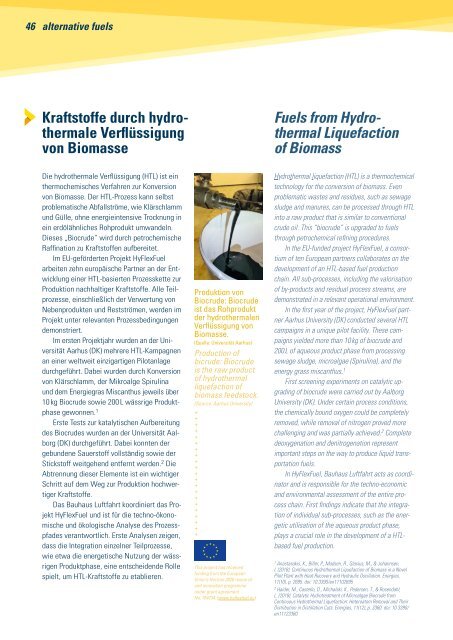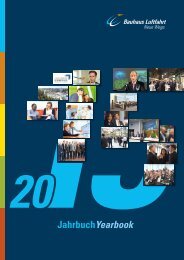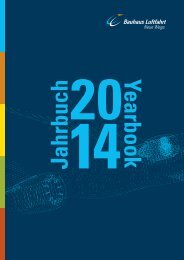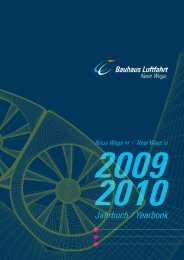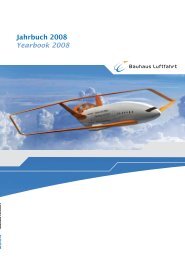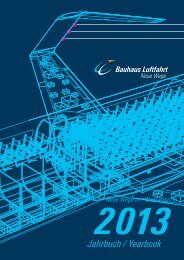Bauhaus Luftfahrt Jahrbuch 2018
You also want an ePaper? Increase the reach of your titles
YUMPU automatically turns print PDFs into web optimized ePapers that Google loves.
46 alternative fuels<br />
Kraftstoffe durch hydrothermale<br />
Verflüssigung<br />
von Biomasse<br />
Fuels from Hydrothermal<br />
Liquefaction<br />
of Biomass<br />
Die hydrothermale Verflüssigung (HTL) ist ein<br />
thermochemisches Verfahren zur Konversion<br />
von Biomasse. Der HTL-Prozess kann selbst<br />
problematische Abfallströme, wie Klärschlamm<br />
und Gülle, ohne energieintensive Trocknung in<br />
ein erdölähnliches Rohprodukt umwandeln.<br />
Dieses „Biocrude“ wird durch petrochemische<br />
Raffination zu Kraftstoffen aufbereitet.<br />
Im EU-geförderten Projekt HyFlexFuel<br />
arbeiten zehn europäische Partner an der Entwicklung<br />
einer HTL-basierten Prozesskette zur<br />
Produktion nachhaltiger Kraftstoffe. Alle Teilprozesse,<br />
einschließlich der Verwertung von<br />
Nebenprodukten und Restströmen, werden im<br />
Projekt unter relevanten Prozessbedingungen<br />
demonstriert.<br />
Im ersten Projektjahr wurden an der Universität<br />
Aarhus (DK) mehrere HTL-Kampagnen<br />
an einer weltweit einzigartigen Pilotanlage<br />
durchgeführt. Dabei wurden durch Konversion<br />
von Klärschlamm, der Mikroalge Spirulina<br />
und dem Energiegras Miscanthus jeweils über<br />
10 kg Biocrude sowie 200 L wässrige Produktphase<br />
gewonnen. 1<br />
Erste Tests zur katalytischen Aufbereitung<br />
des Biocrudes wurden an der Universität Aalborg<br />
(DK) durchgeführt. Dabei konnten der<br />
gebundene Sauerstoff vollständig sowie der<br />
Stickstoff weitgehend entfernt werden. 2 Die<br />
Abtrennung dieser Elemente ist ein wichtiger<br />
Schritt auf dem Weg zur Produktion hochwertiger<br />
Kraftstoffe.<br />
Das <strong>Bauhaus</strong> <strong>Luftfahrt</strong> koordiniert das Projekt<br />
HyFlexFuel und ist für die techno-ökonomische<br />
und ökologische Analyse des Prozesspfades<br />
verantwortlich. Erste Analysen zeigen,<br />
dass die Integration einzelner Teilprozesse,<br />
wie etwa die energetische Nutzung der wässrigen<br />
Produktphase, eine entscheidende Rolle<br />
spielt, um HTL-Kraftstoffe zu etablieren.<br />
Produktion von<br />
Biocrude: Biocrude<br />
ist das Rohprodukt<br />
der hydrothermalen<br />
Verflüssigung von<br />
Biomasse.<br />
(Quelle: Universität Aarhus)<br />
Production of<br />
bicrude: Biocrude<br />
is the raw product<br />
of hydrothermal<br />
liquefaction of<br />
biomass feedstock.<br />
(Source: Aarhus University)<br />
+ + + + + + + + + + + + + + + + + + + + + + + + + + + + + + + + + + + + + +<br />
This project has received<br />
funding from the European<br />
Union’s Horizon 2020 research<br />
and innovation programme<br />
under grant agreement<br />
No. 764734. (www.hyflexfuel.eu)<br />
Hydrothermal liquefaction (HTL) is a thermochemical<br />
technology for the conversion of biomass. Even<br />
problematic wastes and residues, such as sewage<br />
sludge and manures, can be processed through HTL<br />
into a raw product that is similar to conventional<br />
crude oil. This “biocrude” is upgraded to fuels<br />
through petrochemical refining procedures.<br />
In the EU-funded project HyFlexFuel, a consortium<br />
of ten European partners collaborates on the<br />
development of an HTL-based fuel production<br />
chain. All sub-processes, including the valorisation<br />
of by-products and residual process streams, are<br />
demonstrated in a relevant operational environment.<br />
In the first year of the project, HyFlexFuel partner<br />
Aarhus University (DK) conducted several HTL<br />
campaigns in a unique pilot facility. These campaigns<br />
yielded more than 10 kg of biocrude and<br />
200 L of aqueous product phase from processing<br />
sewage sludge, microalgae (Spirulina), and the<br />
energy grass miscanthus. 1<br />
First screening experiments on catalytic upgrading<br />
of biocrude were carried out by Aalborg<br />
University (DK). Under certain process conditions,<br />
the chemically bound oxygen could be completely<br />
removed, while removal of nitrogen proved more<br />
challenging and was partially achieved. 2 Complete<br />
deoxygenation and denitrogenation represent<br />
important steps on the way to produce liquid transportation<br />
fuels.<br />
In HyFlexFuel, <strong>Bauhaus</strong> <strong>Luftfahrt</strong> acts as coordinator<br />
and is responsible for the techno-economic<br />
and environmental assessment of the entire process<br />
chain. First findings indicate that the integration<br />
of individual sub-processes, such as the energetic<br />
utilisation of the aqueous product phase,<br />
plays a crucial role in the development of a HTLbased<br />
fuel production.<br />
1<br />
Anastasakis, K., Biller, P., Madsen, R., Glasius, M., & Johannsen,<br />
I. (<strong>2018</strong>). Continuous Hydrothermal Liquefaction of Biomass in a Novel<br />
Pilot Plant with Heat Recovery and Hydraulic Oscillation. Energies,<br />
11(10), p. 2695. doi: 10.3390/en11102695<br />
2<br />
Haider, M., Castello, D., Michalski, K., Pedersen, T., & Rosendahl,<br />
L. (<strong>2018</strong>). Catalytic Hydrotreatment of Microalgae Biocrude from<br />
Continuous Hydrothermal Liquefaction: Heteroatom Removal and Their<br />
Distribution in Distillation Cuts. Energies, 11(12), p. 3360. doi: 10.3390/<br />
en11123360


